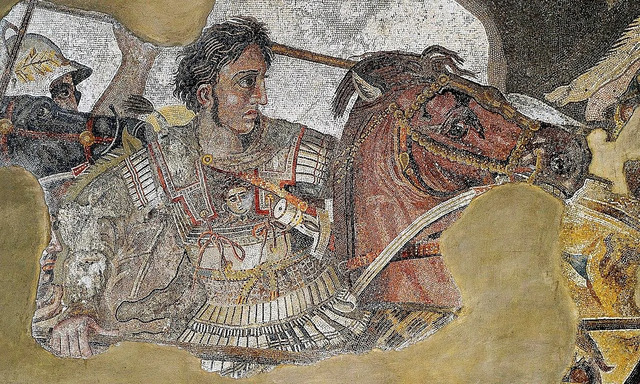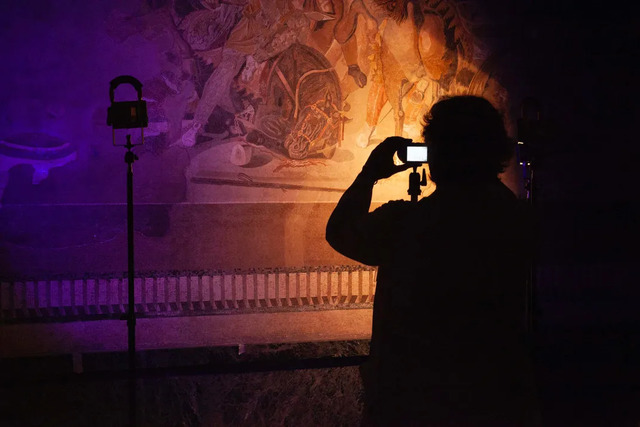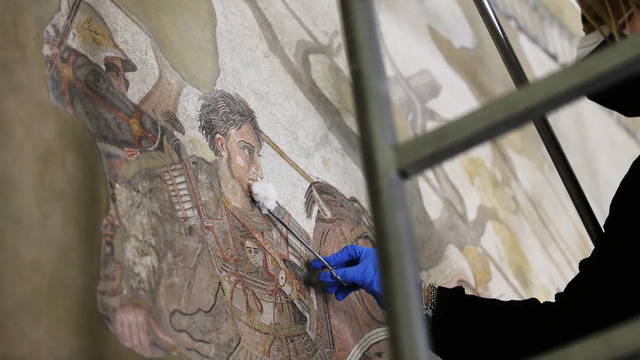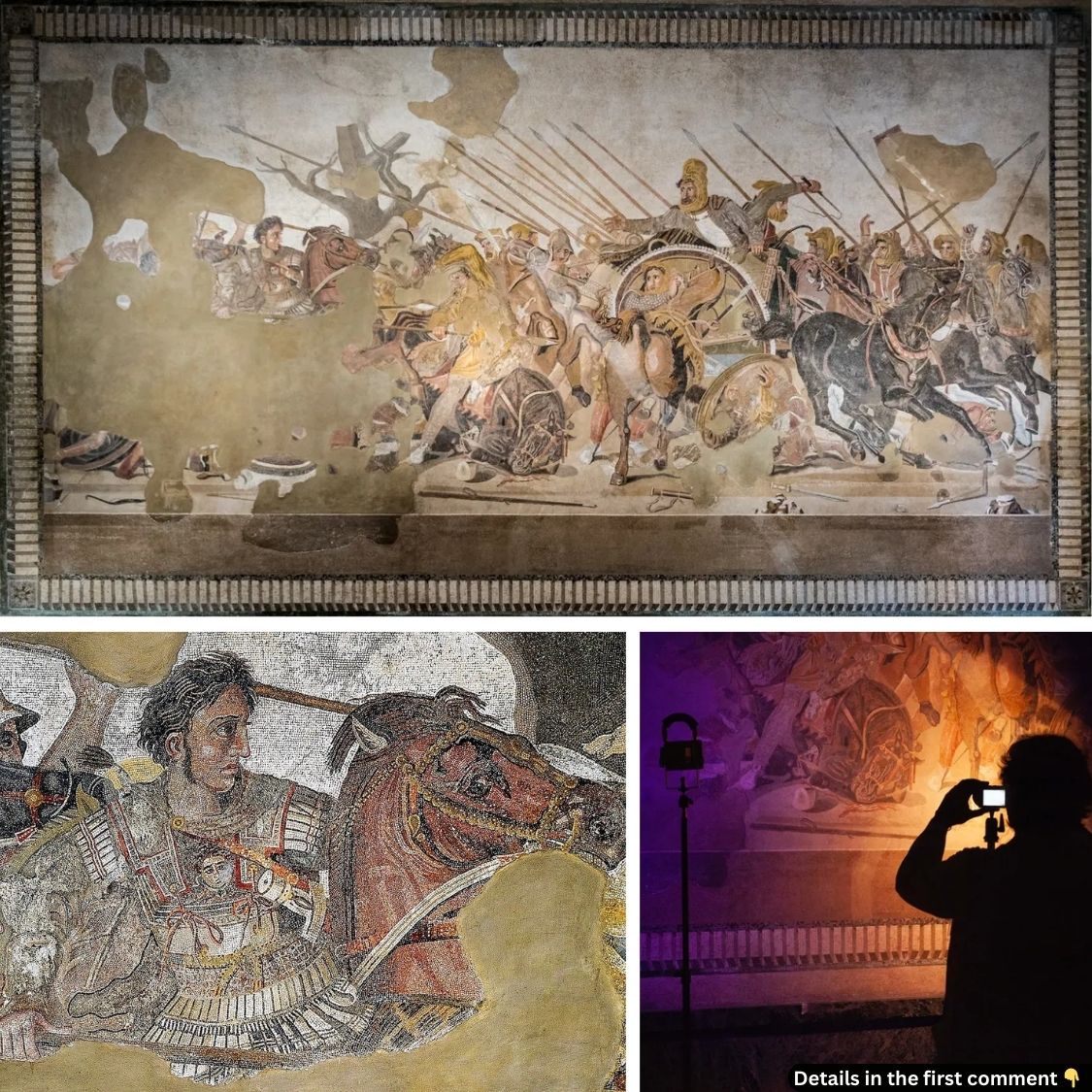The Alexander Mosaic, a masterpiece of ancient art, continues to captivate historians and art lovers alike. Discovered in the ruins of Pompeii, this stunning portrayal of Alexander the Great’s victory at the Battle of Issus is more than just a beautiful piece of craftsmanship; it is a window into the past. With nearly 2 million pieces, the mosaic reveals insights into the artistry of its creators and the materials sourced from across the Roman Empire. New research is uncovering even more secrets, shedding light on its origins and the legacy of one of history’s greatest figures.
The Discovery of the Mosaic
The Alexander the Great mosaic was discovered in 1831 within the opulent House of the Faun in Pompeii. This wealthy Roman residence, known for its intricate and stunning artwork, housed the mosaic, which covers a substantial portion of the floor. Measuring approximately 12 x 17 feet, the artwork depicts a pivotal moment in history: the Battle of Issus in 333 BCE. This battle, fought between the forces of Alexander the Great and the Persian king Darius III, marked a turning point in Alexander’s conquests, showcasing his military genius and the might of the Macedonian army.

At the time of its discovery, the mosaic’s fine details and vibrant colors immediately drew attention. What stood out most was its unparalleled depiction of Alexander. The skillful use of tesserae, or small pieces of colored stone, glass, and other materials, brought the figures to life with extraordinary realism. The mosaic’s depiction of Alexander’s determined expression as he charges into battle has made it one of the most iconic representations of the Macedonian ruler in art.
Video
Watch the video to explore the stunning Alexander Mosaic from the House of the Faun in Pompeii. This incredible artwork offers a glimpse into ancient Roman life and culture!
An In-Depth Look at the Craftsmanship
The mosaic, created with nearly 2 million tesserae, demonstrates the immense skill of ancient Roman artisans. Its painstaking attention to detail and lifelike quality reflect a mastery of the opus vermiculatum technique, which uses very small tesserae to create smooth, flowing lines and a rich texture.

Researchers and conservators have conducted extensive studies to understand the mosaic’s composition and materials. Through non-invasive techniques like portable X-ray fluorescence (pXRF), multispectral imaging, and infrared thermography, scientists have identified ten distinct colors of tesserae in the mosaic. These colors, which include shades of pink, red, yellow, blue, green, and brown, were made from stones and minerals sourced from all over the Roman Empire.
Some of the materials used in the mosaic were from quarries as far afield as Italy, Tunisia, Greece, and the Iberian Peninsula. The white tesserae, for example, are believed to be made from Marmor Lunensis, a high-quality marble from Italy. The pink tesserae may have originated from Portuguese quarries, while some of the darker hues may come from the Iberian Peninsula. This widespread sourcing of materials speaks to the vast network of trade and communication that existed in the Roman Empire, where goods and ideas flowed freely across great distances.
The Mosaic’s Artistic Legacy
The face of Alexander in the mosaic is of particular interest to scholars. Researchers have noted that the artist paid close attention to the luminescence effects of the tesserae, particularly in the use of varying shades of pink to capture the features of Alexander’s face. This level of detail is what makes the portrait so recognizable and lifelike. In fact, the mosaic’s depiction of Alexander’s face has become one of the most iconic in ancient art, capturing the ruler’s intensity and vision with unparalleled realism.

The overall composition of the mosaic offers a dynamic view of the Battle of Issus, with Alexander charging forward on horseback, spear in hand, as Darius III’s forces scramble to retreat. The mosaic vividly captures the chaos and energy of battle, highlighting the skill of the Roman artist in translating a historical event into a powerful visual narrative.
The Mosaic’s Preservation and Modern Restoration
Given its age and significance, the Alexander the Great mosaic has undergone various restoration efforts over the centuries. When it was first discovered, the mosaic was in relatively good condition, but it still required careful conservation. In 1843, the mosaic was transferred to the National Archaeological Museum of Naples (MANN), where it has remained ever since.

In 2020, the museum launched an extensive restoration project, employing advanced scientific techniques to assess and preserve the mosaic. One of the challenges faced by conservators was the presence of gypsum and wax residues on the surface, which were applied during previous conservation efforts. These substances, while offering temporary protection, have contributed to the degradation of the mosaic’s surface over time.

Endoscopic investigations of the mosaic’s backside revealed areas of weakness that could potentially compromise its structural integrity. These voids, along with adhesive residues, highlight the need for ongoing careful restoration. The use of multispectral imaging has helped identify areas where the tesserae may have been dislodged or are beginning to deteriorate, allowing for targeted interventions to preserve the mosaic for future generations.

A Glimpse into Ancient Roman Art and Culture
The Alexander Mosaic is more than just an artwork—it is a window into the world of ancient Rome and the empire’s vast cultural exchanges. By examining the mosaic’s materials, composition, and artistry, modern scholars are uncovering new details about the Roman approach to art, as well as the role that Alexander the Great played in shaping the cultural landscape of the ancient world. The mosaic serves as a testament to the grandeur of Roman craftsmanship and the empire’s commitment to commemorating historical events through art.
As restoration efforts continue, scholars hope to further uncover the secrets behind this masterpiece. The research not only deepens our understanding of the mosaic itself but also sheds light on the ancient world’s artistic and cultural practices. The Alexander Mosaic, with its brilliant depiction of Alexander’s victory, will undoubtedly remain one of the most important artifacts from the Roman period, offering insights into both the history of Alexander the Great and the art of the ancient world.
Video
Check out the video to explore the House of the Faun in Pompeii, Italy, and the famous Alexander Mosaic. This remarkable piece of art takes you back to the grandeur of ancient Rome!
Conclusion
The Alexander the Great mosaic is a timeless treasure that connects the ancient world to the present day. Its rich colors, intricate details, and historical significance continue to fascinate scholars and visitors alike. Through the innovative restoration techniques and scientific studies conducted over the years, we are able to gain a deeper understanding of this monumental work of art. As we look to the future, the Alexander Mosaic will remain a symbol of Roman artistry, historical memory, and the enduring legacy of Alexander the Great’s empire.



